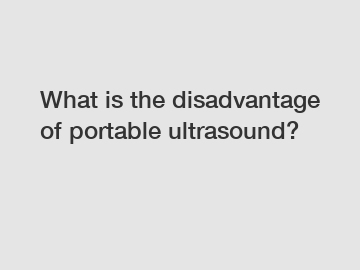What is the disadvantage of portable ultrasound?
In the realm of medical imaging technology, portable ultrasound machines have revolutionized the way healthcare providers diagnose and monitor patients. With their compact design and ease of use, these devices have become invaluable tools in various clinical settings. However, like any innovation, portable ultrasound machines come with their own set of limitations and challenges. In this article, we delve into the disadvantages of portable ultrasound technology, shedding light on the lesser-known trade-offs that one must consider when utilizing these devices.
1. Limited Imaging Capabilities:
While portable ultrasound machines have come a long way in terms of image quality, they still fall short when compared to their larger, more sophisticated counterparts. Due to their smaller digital arrays and limited processing capabilities, portable ultrasound machines struggle to provide the same level of image resolution and detail as their stationary counterparts. This can pose challenges when trying to perform precise diagnoses or locate subtle abnormalities.

2. Reduced Depth Penetration:
Another drawback associated with portable ultrasound machines is their limited depth penetration. The handheld devices generally have less power compared to larger machines, resulting in reduced tissue penetration. This limitation becomes particularly apparent when imaging patients with larger body masses or those with deeper-seated organs. Consequently, healthcare providers may face difficulties obtaining accurate images that encompass the entirety of the area of interest.
3. Operator Dependency:
Despite their user-friendly interfaces, portable ultrasound machines still require skilled operators who possess a thorough understanding of anatomy and imaging principles. In the hands of an inexperienced user, the quality of images obtained may be compromised, leading to misinterpretations or missed diagnoses. Proficient training and expertise are necessary to maximize the potential of portable ultrasound machines and ensure accurate diagnosis and management decisions.
4. Limited Specialty Applications:
Portable ultrasound machines, by their very nature, are designed to be versatile and adaptable to multiple clinical scenarios. However, their portability often comes at the expense of specialized features that are specific to certain medical specialties. For instance, advanced echocardiography or specialized vascular studies may require additional tools or probes that are not easily integrated into portable devices. Thus, healthcare providers may find themselves limited in their ability to offer certain advanced diagnostic services in the field using portable ultrasound machines alone.
5. Higher Cost:
While portable ultrasound machines provide significant benefits in terms of mobility and convenience, they tend to be more expensive than traditional ultrasound devices. The compact design and advanced technology packed into these portable devices often come at a premium cost, making them less accessible for healthcare facilities with limited budgets. This cost disparity may restrict smaller clinics or resource-limited settings from fully harnessing the potential of this technology.
Conclusion:
Portable ultrasound machines undoubtedly offer numerous advantages in terms of convenience, mobility, and accessibility. They have proved to be valuable assets in various clinical settings, facilitating rapid diagnoses, and enhancing patient care. However, it is necessary to acknowledge and understand the limitations associated with portable ultrasound technology. From limited imaging capabilities to reduced depth penetration and operator dependency, these disadvantages highlight the need for appropriate training, cautious interpretation, and supplementary diagnostic resources when employing portable ultrasound machines.
By recognizing and addressing these challenges, healthcare providers can make informed decisions regarding the use of portable ultrasound machines, ensuring their integration into the medical field is both safe and effective. As technology progresses, it is likely that many of these limitations will be gradually overcome, leading to even more refined portable ultrasound devices that enhance patient care while minimizing the trade-offs currently associated with this technology.
If you are looking for more details, kindly visit pregnancy ultrasound machine, how much does an ultrasound machine cost, chison cbit 5.


